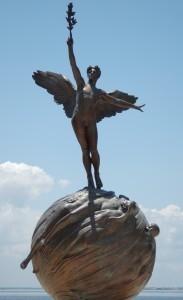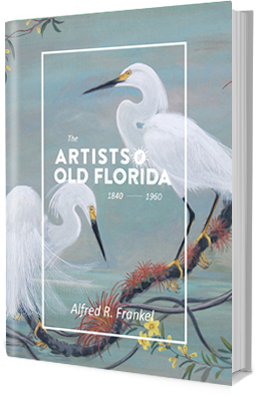C. Adrian Pillars was a distinguished artist and, at the turn of the century, the leading sculptor in Florida. Pillars was assistant to sculptors Daniel Chester French and E.C. Potter at the Columbian Exposition, the Chicago World’s Fair, 1891-93, working on the equestrian statues of the Columbus Quadrangle, and The Republic. Pillars established a studio in St. Augustine in 1894, and later moved to Jacksonville, where he is listed in the city directory in 1901. He moved back to St. Augustine in 1914 and in January 1924, was a charter member of the Pen and Brush Club of St. Augustine, the name shortly changed to The Galleon, a literary and art club. Under Pillars direction the Galleon offered classes in clay modeling and sculpture.
The St. Augustine Record, January 15, 1929, “It is interesting to note in connection with the city flag, which flies at the old City Gates, and which is also displayed over the city on gala occasions, that C. Adrian Pillars, sculptor, supplied the design for this flag.” Pillars moved back to Jacksonville in 1931, stating: “A wider field of action for my work…makes it imperative to be located in a larger city.” Pillars did portrait medallions of early Jacksonville banker, Bion H. Barnett, Barnett’s sons; Mrs. Harrison Reid and Senator Duncan U. Fletcher. He was commissioned to honor Florida’s 1200 soldiers, sailors and marines, who died in World War I, with a monument. He called the statue, Spiritualized Life, The Winged Victory.
The Jacksonville Florida Times Union March 20, 1974, quotes Pillars, “The bronze grouping was conceived in an effort to create some form of memorial which would be an external reminder of the boys who sacrificed themselves in the World War. I desired the memorial to present the idea of life, its struggle, and victory. While struggling to make a composition visualizing this, I found a poem by Allan Seegar, a soldier-victim of the war. ‘I Have a Rendezvous With Death.’ I saw those boys giving up their homes, sweethearts, wives and mothers to go overseas and through the supreme sacrifice, make secure the happiness and safety of their loved ones. With this vivid picture in mind, I constructed a sphere to represent the world, engirdled with masses of swirling water, typifying the chaotic earth forces. In this surging mass of waters, I shaped human figures, all striving to rise above this flood, struggling for mere existence.”
One of Pillars’ daughters posed for the child figures on the globe. The statue, now in Memorial Park in Jacksonville, was dedicated on Christmas day, 1924. In the St. Augustine Plaza stands Pillars’ bronze Memorial Flagstaff, erected to the men of St. Johns County who were killed in World War I, and in Trinity Episcopal Church is a private memorial tablet in bronze, designed by him. His statue’s of General Kirby Smith, CSA, Florida’s famous Confederate Civil War general, and his statue of Dr. John Gorrie, inventor of artificial ice (refrigeration, air conditioning) were chosen to represent the State of Florida in the United States Capital Building’s Hall of Fame, in Washington, D.C. In 1933 Pillars was chosen by the State of Florida as Special Art Juror to pass on murals, state building, Florida, Chicago Century of Progress. Pillars is listed as an artist working for the government in the Report of the Assistant Secretary of the Treasury to Federal Emergency Relied Administration, December 8, 1933-June 30, 1934. He was an instructor at the Ringling School of Art in Sarasota from 1932 to 1935. His last large work was the bronze statue of Mr. W. B. Barnett, the founder and first president of the Barnett National Bank. His replica of the original marker put up by Jean Ribault in 1562, near Mayport, was done for the Maria Jefferson Chapter of the D.A.R., and now stands in Ft. Caroline State Park.
Florence Seymour, a leading Jacksonville artist, and president of the Florida Federation of Art in 1959, knew Pillars well. She first met him in 1936 while working for the Florida Arts Project as part of the WPA. Pillars was giving sculpting lessons, and Seymour’s daughter Florine, posed for the classes. After finishing Neptune, a statue for Jacksonville Beach, Pillars began plans for Lure of the Sea, (never finished). Seymour said, “We involved Jacksonville debutantes in a contest to find the model for the statue. She recalled Pillars as, “A charming fellow, very refined, he was probably no taller than 5 foot 9, and wore a little bow tie and sometimes a black coat with long tail. He was kind, compassionate…”
In 1963 a group of Jacksonville citizens including Florence Seymour, her husband, Russell Seymour, Ruth Pillars Stewart and Kitti Winter, formed the Charles Adrian Pillars Memorial Society to, “Perpetuate the name of Charles Adrian Pillars, by hand molding and casting the original sketches created by Pillars during his lifetime.” These Pillars copies included The Wind Goddess, executed 1894, Spiritualized Life-Winged Victory, Memorial Park, Jacksonville executed 1924, The Storm, a mask executed 1888, Solitude, executed 1928, and The Fallen Leaf, executed 1934. England’s Queen Elizabeth purchased Spiritualized Life-Winged Victory.




